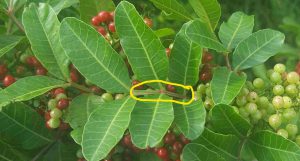Despite producing red “holly-like” berries during the holiday season, Brazilian peppertree is not a native Florida holly.
People who mistake this plant for a Florida holly might be in for a rude surprise. Brazilian peppertree is more closely related to poison ivy than native Florida hollies. Both Brazilian peppertree and poison ivy belong to the Anacardiaceae family of plants.
The winged midrib is one of the ways to tell the difference between Brazilian peppertree and native Florida hollies. Brazilian peppertree has a winged midrib while native Florida hollies do not.

Anyone who has a basic biology course knows there are problems when using common names. There are often regional common names for plants and animals. The same exact living thing can have different common names depending where people live. This is why some people call Brazilian peppertree the Florida holly.
Carl Linnaeus recognized this as a problem and is credited with the development of binomial nomenclature which provides a standardized way of naming living things. Scientists generally use this system when researching living things. Unfortunately, the general public often cringes whenever scientists use the terms genus and species. Brazilian peppetree is a Florida example of why the system developed by Linnaeus is so important.
Schinus terebinthifolia is the genus and species name for Brazilian peppertree (Gioeli, Enloe, Minteer and Langeland 2018). Florida hollies belong to the genus Ilex…not the genus Schinus. Its most likely that the Florida holly common name stuck because of its red berries which are found on the plant during the November and December holiday season. Schinus terebithifolia is recognized as an invasive weed species while Ilex such as Dahoon holly(Cuda et al. 2006).
If you want to learn more about Brazilian peppertree, its impacts on the Florida environment and how to manage it, please read our UF/IFAS Brazilian peppertree control recommendations.
References
Gioeli, K., Enloe, S., Minteer, C., Langeland, K. 1997. (Revised 2012, 2018). Brazilian peppertree Control. SS-AGR-17. UF/IFAS EDIS https://edis.ifas.ufl.edu/aa219.
Cuda, J. P., A. P. Ferriter, V. Manrique, and J. C. Medal. 2006. Florida’s Brazilian Peppertree Management Plan: Recommendations from the Brazilian Peppertree Task Force, 2nd Edition. Florida Exotic Pest Plant Council. http://www.fleppc.org/Manage_Plans/2006BPmanagePlan5.pdf
 1
1
